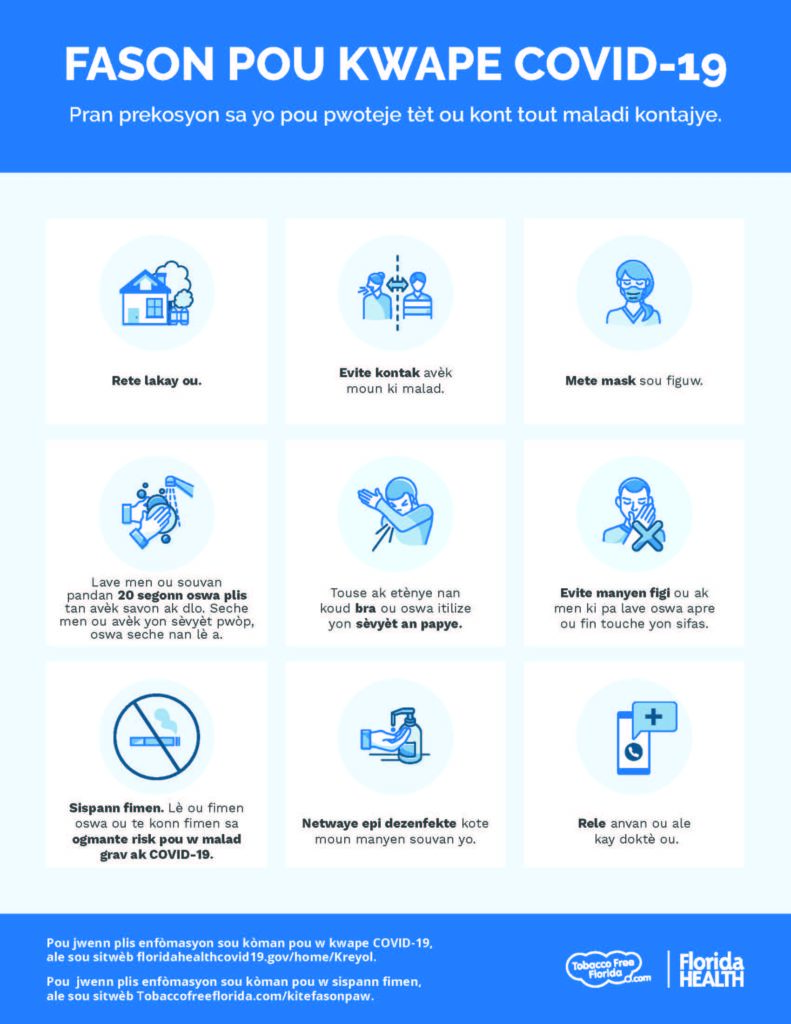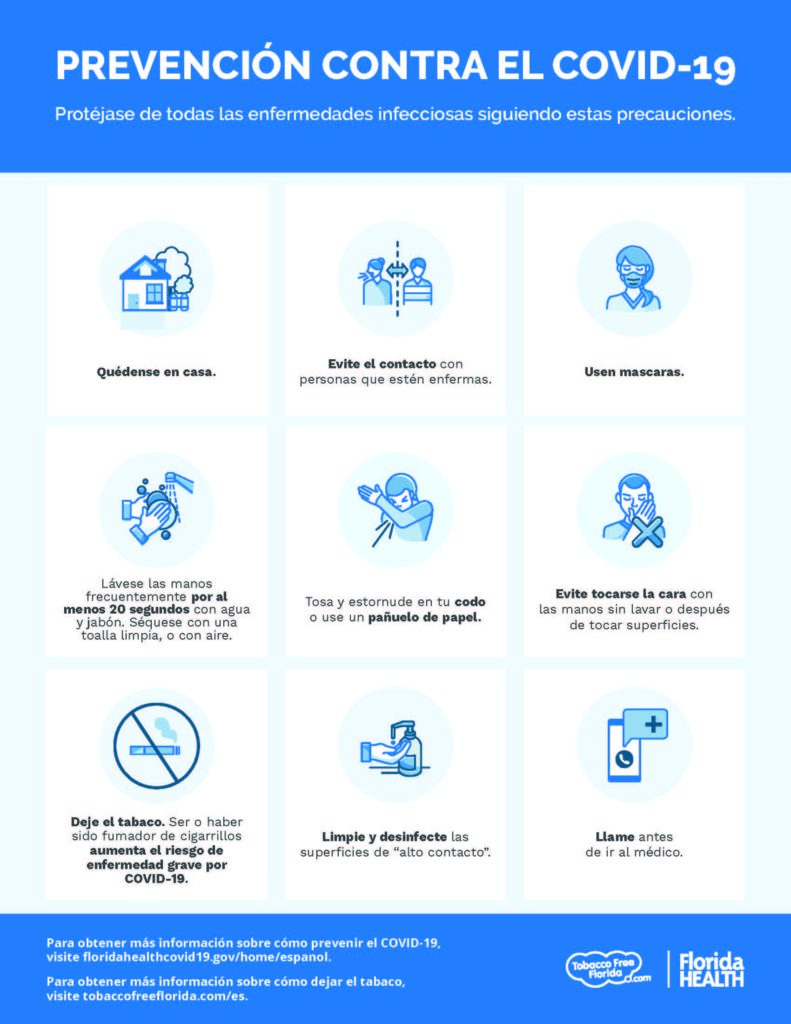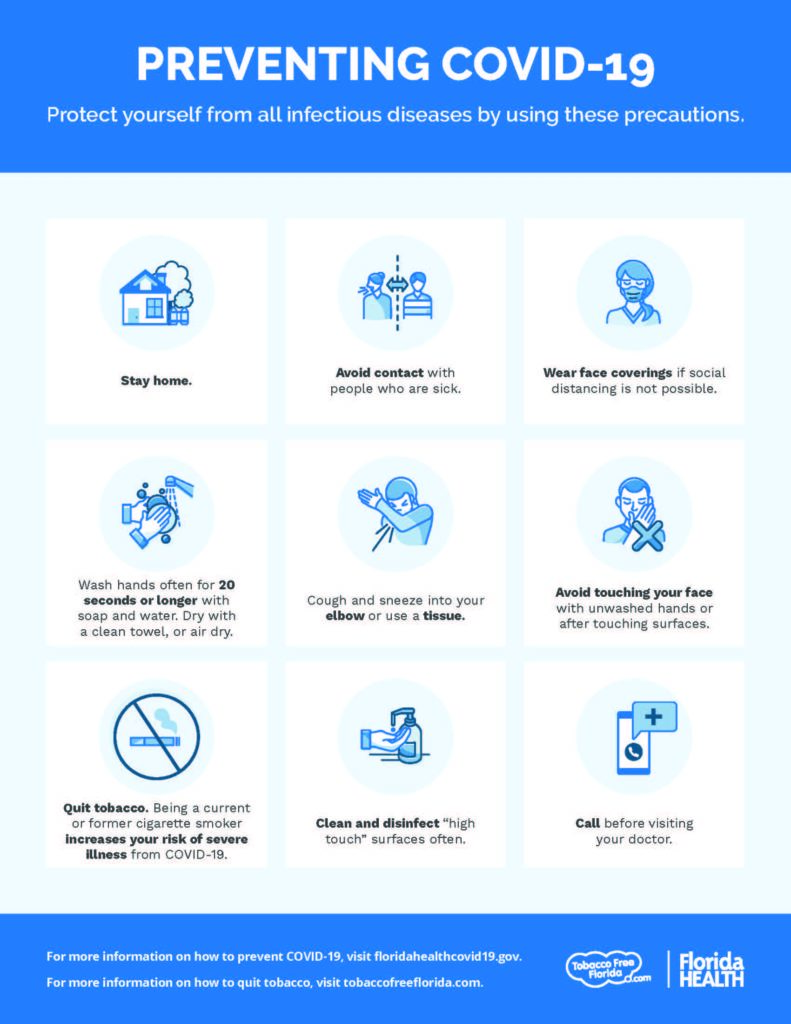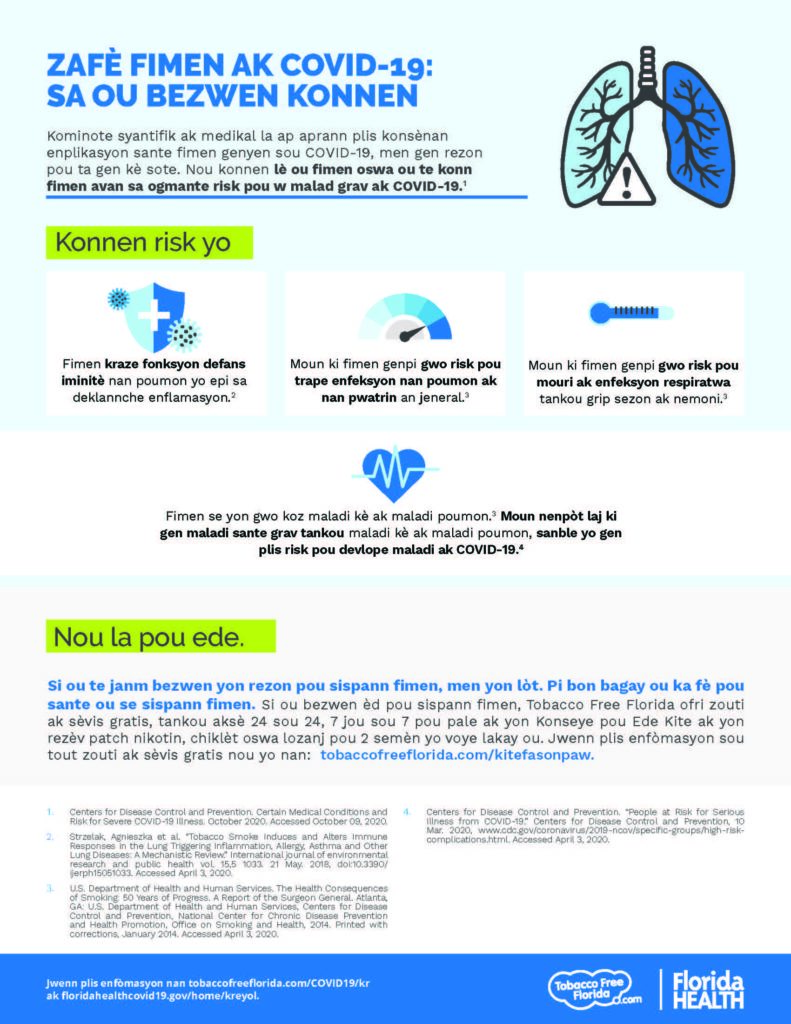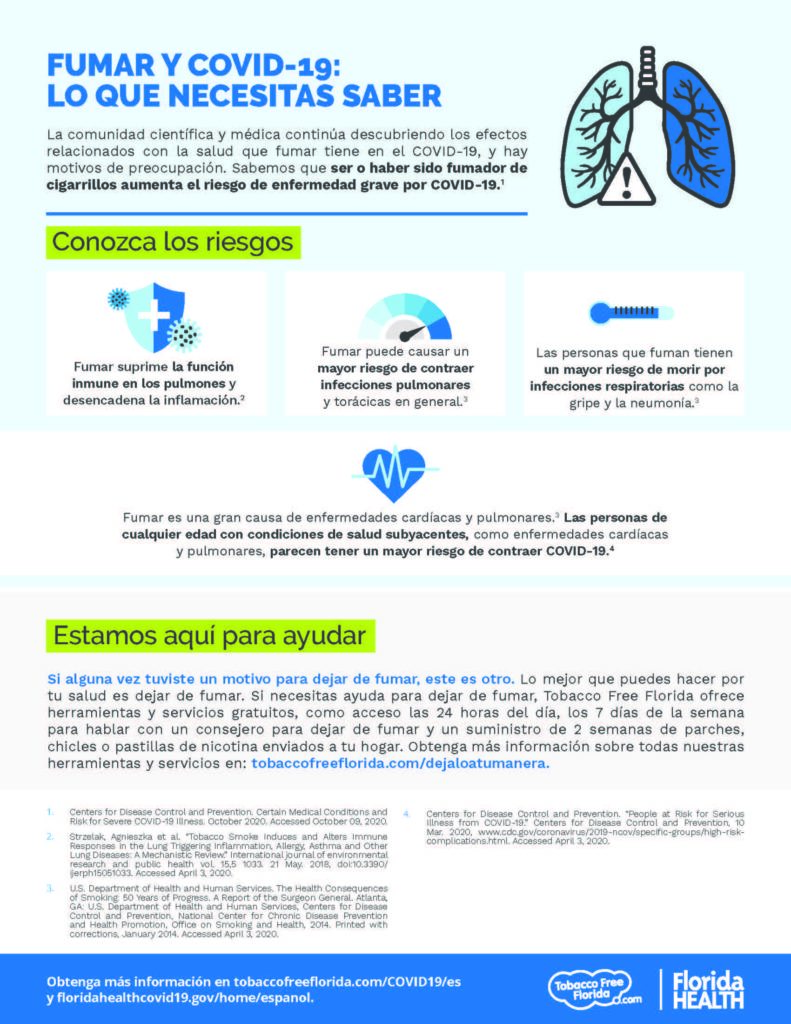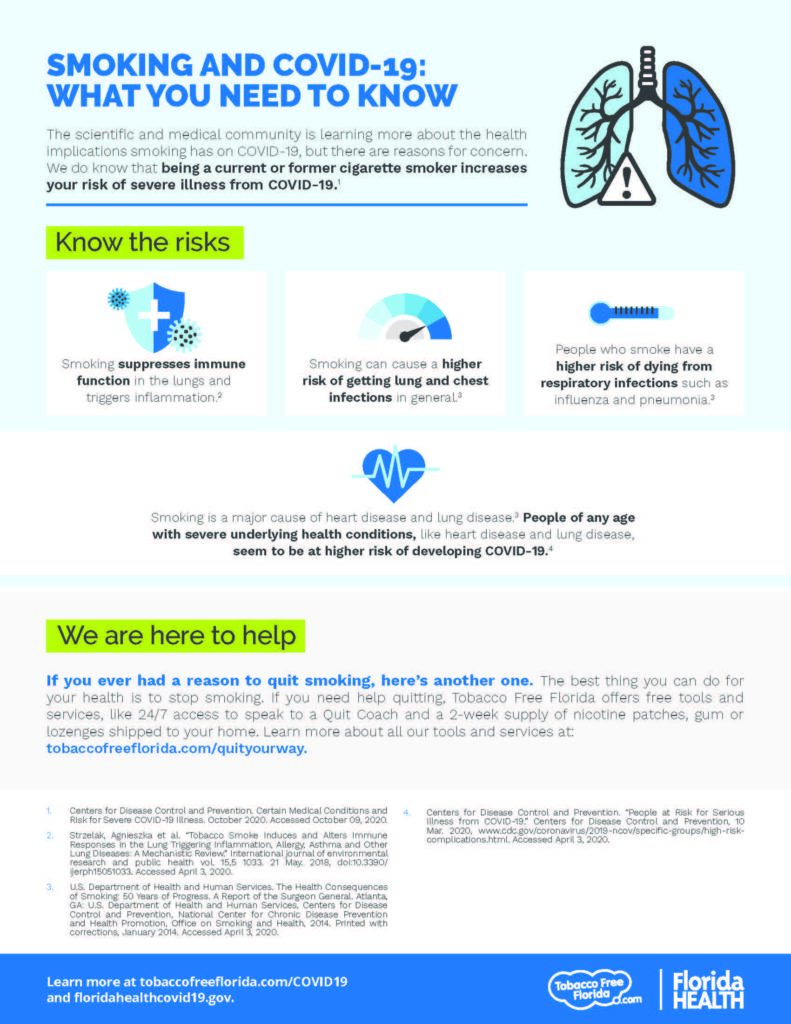Los peligros del humo de segunda mano
No hay un nivel seguro de exposición al humo de segunda mano; incluso la exposición breve puede ser dañina para la salud. 1, 2 El humo de segunda mano es el que proviene de la combustión de productos de tabaco, como cigarrillos, cigarros y pipas. 1, 3
El humo de segunda mano es también el que exhala una persona que está fumando. 1, 3, 4, Este humo contiene más de 7,000 sustancias químicas, de las cuales cientos son tóxicas y unas 70 pueden causar cáncer. 1
En Estados Unidos, todos los años mueren cerca de 41,000 adultos que no fuman como consecuencia de una enfermedad causada por la exposición al humo de segunda mano. Este puede causar enfermedad coronaria, derrames cerebrales y cáncer de pulmón. 1, 3
- El riesgo de padecer de una enfermedad cardíaca entre los no fumadores que están expuestos al humo de segunda mano en el hogar o en el trabajo aumenta del 25 al 30%. 5
- El humo de segunda mano aumenta el riesgo de sufrir un derrame cerebral de 20 a 30%. 6
- El riesgo de contraer cáncer pulmonar aumenta del 20% al 30% entre los no fumadores que están expuestos al humo de segunda mano en el hogar o en el trabajo. 7
¿Cuán dañino es el humo de segunda mano?
El humo de segunda mano nos afecta a todos, especialmente a los niños. El lugar principal donde los niños pequeños están expuestos al humo de segunda mano es en sus hogares. 8 Estos son los datos: 9, 10
- Los estudios demuestran que los niños mayores de padres fumadores se enferman con más frecuencia. Sus pulmones crecen menos que los de los niños que no respiran humo de segunda mano y contraen más bronquitis y neumonía.
- El humo de segunda mano puede provocar ataques de asma. Los niños asmáticos que están expuestos al humo de segunda mano padecen de ataques de asma más intensos y con mayor frecuencia. Un ataque de asma severo puede poner en peligro la vida de un niño.
- Los niños cuyos padres fuman en su presencia padecen de infecciones del oído con más frecuencia. También padecen de acumulación de líquido en el oído con más frecuencia y tienen que ser sometidos a más operaciones para insertarles tubos de drenaje.
El humo de segunda mano incrementa el riesgo del Síndrome de Muerte Súbita del Infante (SIDS por sus siglas en inglés), que es la muerte repentina e inesperada de un niño durante su primer año de vida. 11, 12
- Fumar durante el embarazo aumenta el riesgo de SIDS. 13, 14
- Los bebés que están expuestos al humo de segunda mano después de nacer también corren un mayor riesgo de morir de SIDS. 15, 16
- SIDS es la principal causa de muerte entre los bebés que son de otro modo saludables. 17
La única manera de proteger completamente a los no fumadores sería que nadie fumara en ninguna casa, centro de trabajo o lugar público. Puedes protegerte a ti mismo y a tu familia del humo de segunda mano haciendo lo siguiente:
1 U.S. Department of Health and Human Services. The Health Consequences of Smoking—50 Years of Progress: A Report of the Surgeon General. Atlanta: U.S. Department of Health and Human Services, Centers for Disease Control and Prevention, National Center for Chronic Disease Prevention and Health Promotion, Office on Smoking and Health, 2014 [accessed 2019 July 24].
2 U.S. Department of Health and Human Services. A Report of the Surgeon General: How Tobacco Smoke Causes Disease: What It Means to You. Atlanta: U.S. Department of Health and Human Services, Centers for Disease Control and Prevention, National Center for Chronic Disease Prevention and Health Promotion, Office on Smoking and Health, 2010 [accessed 2019 July 24].
3 Institute of Medicine. Secondhand Smoke Exposure and Cardiovascular Effects: Making Sense of the EvidenceExternal. Washington: National Academy of Sciences, Institute of Medicine, 2009 [accessed 2019 July 24].
4 U.S. Department of Health and Human Services. The Health Consequences of Involuntary Exposure to Tobacco Smoke: A Report of the Surgeon General. Atlanta: U.S. Department of Health and Human Services, Centers for Disease Control and Prevention, National Center for Chronic Disease Prevention and Health Promotion, Office on Smoking and Health, 2006 [accessed 2019 July 24].
5 U.S. Department of Health and Human Services. Let’s Make the Next Generation Tobacco-Free: Your Guide to the 50th Anniversary Surgeon General’s Report on Smoking and Health. Atlanta: U.S. Department of Health and Human Services, Centers for Disease Control and Prevention, National Center for Chronic Disease Prevention and Health Promotion, Office on Smoking and Health, 2014 [accessed 2019 July 23].
6 U.S. Department of Health and Human Services. The Health Consequences of Smoking—50 Years of Progress: A Report of the Surgeon General. Atlanta: U.S. Department of Health and Human Services, Centers for Disease Control and Prevention, National Center for Chronic Disease Prevention and Health Promotion, Office on Smoking and Health, 2014
7 U.S. Department of Health and Human Services. The Health Consequences of Involuntary Exposure to Tobacco Smoke: A Report of the Surgeon General. Atlanta: U.S. Department of Health and Human Services, Centers for Disease Control and Prevention, National Center for Chronic Disease Prevention and Health Promotion, Office on Smoking and Health, 2006
8 Centers for Disease Control and Prevention. Vital Signs: Nonsmokers’ Exposure to Secondhand Smoke—United States, 1999–2008. Morbidity and Mortality Weekly Report 2010;59(35):1141–6 [accessed 2015 Feb 6].
9 U.S. Department of Health and Human Services. The Health Consequences of Involuntary Exposure to Tobacco Smoke: A Report of the Surgeon General external icon. Atlanta: U.S. Department of Health and Human Services, Centers for Disease Control and Prevention, National Center for Chronic Disease Prevention and Health Promotion, Office on Smoking and Health, 2006
10 U.S. Department of Health and Human Services. The Health Consequences of Smoking—50 Years of Progress: A Report of the Surgeon General. Atlanta: U.S. Department of Health and Human Services, Centers for Disease Control and Prevention, National Center for Chronic Disease Prevention and Health Promotion, Office on Smoking and Health, 2014
11 U.S. Department of Health and Human Services. The Health Consequences of Involuntary Exposure to Tobacco Smoke: A Report of the Surgeon General. Atlanta: U.S. Department of Health and Human Services, Centers for Disease Control and Prevention, National Center for Chronic Disease Prevention and Health Promotion, Office on Smoking and Health, 2006
12 U.S. Department of Health and Human Services. The Health Consequences of Smoking—50 Years of Progress: A Report of the Surgeon General. Atlanta: U.S. Department of Health and Human Services, Centers for Disease Control and Prevention, National Center for Chronic Disease Prevention and Health Promotion, Office on Smoking and Health, 2014
13 U.S. Department of Health and Human Services. The Health Consequences of Involuntary Exposure to Tobacco Smoke: A Report of the Surgeon General. Atlanta: U.S. Department of Health and Human Services, Centers for Disease Control and Prevention, National Center for Chronic Disease Prevention and Health Promotion, Office on Smoking and Health, 2006
14 U.S. Department of Health and Human Services. The Health Consequences of Smoking—50 Years of Progress: A Report of the Surgeon General. Atlanta: U.S. Department of Health and Human Services, Centers for Disease Control and Prevention, National Center for Chronic Disease Prevention and Health Promotion, Office on Smoking and Health, 2014
15 U.S. Department of Health and Human Services. The Health Consequences of Involuntary Exposure to Tobacco Smoke: A Report of the Surgeon General. Atlanta: U.S. Department of Health and Human Services, Centers for Disease Control and Prevention, National Center for Chronic Disease Prevention and Health Promotion, Office on Smoking and Health, 2006
16 U.S. Department of Health and Human Services. The Health Consequences of Smoking—50 Years of Progress: A Report of the Surgeon General. Atlanta: U.S. Department of Health and Human Services, Centers for Disease Control and Prevention, National Center for Chronic Disease Prevention and Health Promotion, Office on Smoking and Health, 2014
17 Murphy, S. L., Xu, J., & Kochanek, K. D. (2013). Deaths: Final report for 2010. National Vital Statistics Report, vol. 61 no. 4. Retrieved November 11, 2013, from https://www.cdc.gov/nchs/data/nvsr/nvsr61/nvsr61_04.pdf [accessed 2019 July 23]



